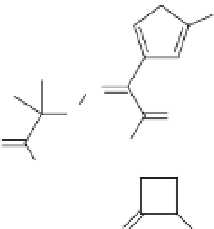Chemistry Reference
In-Depth Information
O
H
H
H
CH
3
R
C
N
N
O
SO
3
H
Monobactam
FIGURE 9.7
The core monobactam chemical structure, R represents various amino acid
side chains.
S
NH
2
N
N
O
O
O
HN
CH
3
OH
N
SO
3
H
O
FIGURE 9.8
The commercial monobactam Aztreonam (Azactam).
acid moiety (Figure 9.7). In 1981, researchers in Japan and in the United States
independently discovered the monobactams. These compounds were discovered
from soil bacteria and detected using supersensitive antimicrobial screens with
Pseudomonas aeruginosa
and
Escherichia coli
.
The first monobactams reported were given the names sulfazecin and iso-
sulfazecin (N-acyl derivatives of (S)-3-amino-2-oxo-1-azetidine sulfonic acid
(3-aminomonobactamic acid)) produced in fermentation from bacterial strains and
not from the more common sources: fungi or actinomycetes. Subsequently, over a
5-year period, 14 naturally occurring monobactams were isolated and characterized
from gram-negative bacteria. These β-lactams produced no side effects: however,
they only possessed a narrow spectrum of activity toward gram-negative organisms,
in contrast to the broad spectrum penicillins and cephalosporins.
These naturally occurring compounds led to the synthesis of many completely
synthetic monobactams. For example, Aztreonam is a totally synthetic analog of the
naturally occurring monobactams (Figure 9.8).
9.7 STRUCTURAL FEATURES
In the IR spectra, in addition to the diagnostic v
max
(cm
-1
) C=O lactam and amide
stretches at 1780 cm
-1
and 1645 cm
-1
, respectively, there are strong well resolved
S=O band stretches around 1240 cm
-1
, reflecting the presence of sulfonic acid
(Figure 9.9). In the mass spectrum a characteristic loss of 80 mu [MH-SO
3
] from the
cleavage of the N-SO
3
bond is generally observed, and is a diagnostic fragment ion.








Search WWH ::

Custom Search